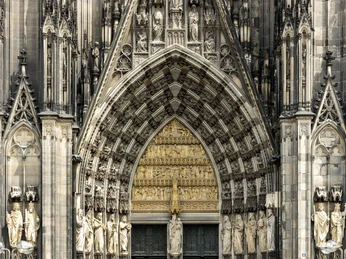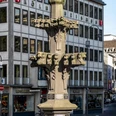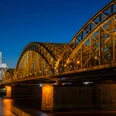Cologne Cathedral — everyone knows this superlative building: It is 157 m tall and the world’s third largest Gothic-style cathedral with 10,000 square metres of windows and 20,000 visitors daily. Some 300,000 tonnes of stones were used in its construction. Maintenance costs per day add up to around €30,000. Its value—priceless, but because it’s unsaleable, it has a book value of €27.
About 100 people from the Dombauhütte (cathedral masonry office) work every day to maintain the Cathedral as Germany's most popular landmark and a UNESCO World Heritage Site. “When the Cathedral is finished, the world will end” is an old Cologne saying. Even after the 632 years of construction, work thus continues on God’s eternal building site.
As a result, the stonemasons and stone sculptors were of great importance — and they still are, because of the extensive amount of conservation work that needs to be done. The black patina has been a characteristic feature of Cologne Cathedral for centuries and is due to weathering, soot and biofouling — and it should stay that way.
The Shrine of the Three Kings, which contains the relics of the Magi, is worthy of mention, as is the 4th century St. Peter’s Staff, which can be seen in the Cathedral’s underground treasure chamber, along with numerous other reliquaries, liturgical utensils, vestments and manuscripts.
Some windows from the Middle Ages have been preserved to this day, others have been restored according to old sketches, and still other windows, such as the Richter window, were created only recently. The Cologne Cathedral windows, their significance, their history and their partial rescue from the bombs of World War II comprise an extensive chapter of the Cathedral’s history and play an important role in the impressive interior.
If you climb up the tower, you’ll have a wonderful view of the city from the Cologne landmark. You will also pass Bell 1, which has acoustically represented the Cathedral with its low C since 1923.
Please note the following when you visit the Cathedral: There is a specific dress code that the Cathedral sacristans will make you aware of at the entrance if you want to enter with headgear or an off-the-shoulder shirt. You can read about the Dress Code here.
About 100 people from the Dombauhütte (cathedral masonry office) work every day to maintain the Cathedral as Germany's most popular landmark and a UNESCO World Heritage Site. “When the Cathedral is finished, the world will end” is an old Cologne saying. Even after the 632 years of construction, work thus continues on God’s eternal building site.
Pilgrimage site, valuable art, mysteries
In addition to the often quoted facts, there is also a lot of mystery hidden in the important pilgrimage site for pious Catholics — and plenty of fascinating items for those interested in art and culture. Examples include: Why did it take so long to build the Cathedral? Why wasn’t the Cathedral damaged more severely during World War II? How does this massive vaulted ceiling hold up anyway? What’s inside the roof? Are there any hidden storage rooms or secret places? And what’s with the many windows? Some of it you will certainly learn during your visit, others only in one of the numerous cathedral tours or after some reading of your own. That’s because the Cathedral harbours plenty of stories, legends and curiosities.Material and patina: Why is the Cathedral black?
The Cathedral is made of different types of stone, such as trachyte and sandstone. Many sculptures and canopies are made of limestone.As a result, the stonemasons and stone sculptors were of great importance — and they still are, because of the extensive amount of conservation work that needs to be done. The black patina has been a characteristic feature of Cologne Cathedral for centuries and is due to weathering, soot and biofouling — and it should stay that way.
The Shrine of the Three Kings and other objects of art
Cologne Cathedral is known for its long drawn-out origins and long period of construction, its building history, which began with the Three Wise Men and ended only in 1880 with its completion, as well as for many important works of art that you can see in the Cathedral and in the Cathedral Treasure Chamber.The Shrine of the Three Kings, which contains the relics of the Magi, is worthy of mention, as is the 4th century St. Peter’s Staff, which can be seen in the Cathedral’s underground treasure chamber, along with numerous other reliquaries, liturgical utensils, vestments and manuscripts.
Cologne Cathedral: Windows
The Cathedral’s colourful glass windows are especially impressive. They bring a vibrant intensity of colour into the interior. Light-flooded cathedrals should make the omnipotence and closeness to God tangible, which explains the plethora of windows. From the very beginning, Cologne Cathedral was also designed with this idea in mind and today it has the largest window area of any church in the world: more than 10,000 square metres. They not only include coloured surfaces, but also picture windows that tell biblical stories. One of the Cathedral’s oldest stained-glass windows is the famous Bible Window, which is located in the central chapel of the ambulatory.Some windows from the Middle Ages have been preserved to this day, others have been restored according to old sketches, and still other windows, such as the Richter window, were created only recently. The Cologne Cathedral windows, their significance, their history and their partial rescue from the bombs of World War II comprise an extensive chapter of the Cathedral’s history and play an important role in the impressive interior.
South transept window by Gerhard Richter: the Richter window
The cathedral window designed by the German artist Gerhard Richter caused quite a stir. Inaugurated in 2007, it sparked enthusiasm as well as criticism. A total of 11,263 colour squares in 72 colours were randomly arranged for the south transept window, which was destroyed during World War II, creating an abstract tapestry of colour that changes continuously depending on the incidence of light. The 72 colours are colours that were also used in the neo-medieval windows of the 19th century and thus are an essential element of the cathedral windows. If you’re in Cologne and near the Cathedral when the sun is shining, you should step inside and see the play of colours for yourself.Lucky coincidence: rafters made of iron
Another successful interplay of tradition and modernity is hidden under the roof of the Cathedral. Contrary to what you may assume, the rafters of the Cathedral’s roof are not made of wood, but of iron, which saved the Cathedral from serious damage in World War II. This iron truss was the largest steel structure in the world in 1860 — 30 years before the completion of the Eiffel Tower. To this day it carries the heavy lead roof.Cologne Cathedral: The city’s hallmark and its heart
The Cathedral and Cologne simply belong together and the church shapes the cityscape. To a Cologne resident, the sight of the Cathedral spires says that you’re home. Today the Cathedral is Cologne’s second-tallest structure, surpassed only by the telecommunications tower. The cathedral covers almost 8,000 square metres of floor space and can hold more than 20,000 people.If you climb up the tower, you’ll have a wonderful view of the city from the Cologne landmark. You will also pass Bell 1, which has acoustically represented the Cathedral with its low C since 1923.
World Heritage Site and hot spot, but still a church
But the cathedral is so much more than a sight, a backdrop, a world heritage site or a tourist magnet, because in the end, despite all the valuable exhibits and art objects in the Cathedral Treasure Chamber, in the interior or on the facade, it remains a church with religious services and music that you can experience in this special atmosphere.Please note the following when you visit the Cathedral: There is a specific dress code that the Cathedral sacristans will make you aware of at the entrance if you want to enter with headgear or an off-the-shoulder shirt. You can read about the Dress Code here.
Useful Information
Eligibility
Bad Weather Offer
Suitable for any weather
for Groups
for Class
for families
for individual guests
Suitable for Pushchair
Openings
Cologne Cathedral is usually open from 6 am to 8 pm.
Outside of liturgical times, it is possible for tourists to visit the cathedral as a World Heritage Site: Generally between 10 a.m. and 5 p.m. on weekdays, 1 p.m. and 4 p.m. on Sundays, and until 8 p.m. in the tower hall after evening mass. Since church services have priority, changes are not excluded.
Outside of liturgical times, it is possible for tourists to visit the cathedral as a World Heritage Site: Generally between 10 a.m. and 5 p.m. on weekdays, 1 p.m. and 4 p.m. on Sundays, and until 8 p.m. in the tower hall after evening mass. Since church services have priority, changes are not excluded.
Payment methods
Entrance Free
Parking facilities
Cologne Cathedral is located in the immediate vicinity of the main railway station and is easy to reach by public transport and car.
More information
All guided tours of the interior of Cologne Cathedral are subject to registration!
They may only be conducted by authorised or registered cathedral guides.
Private individuals, institutions, school classes or travel companies can book a group tour of Cologne Cathedral through the DOMFORUM.
The group size is limited to a maximum of 20 persons per group.
The guided groups will be provided with a group guidance system - if they do not wish to use their own.
A flat rate for the provision of group guidance systems will be charged per group.
Children's and youth groups receive the group guidance systems free of charge.
Children's groups do not have to use a group guidance system until the 5th school year.
The group guidance systems are audio radio systems with a microphone for the guides and receivers for the participants.
The aim is, on the one hand, an acoustic calming of the church space, which should help to be able to protect the interests of visitor groups and worshippers alike.
On the other hand, this technology enables the participants to better understand the explanations on site in the cathedral.
In addition to the flat-rate provision fee, a cathedral fee is charged which, in addition to the handling fee, includes a cathedral levy for the upkeep of the cathedral.
If capacities are available, smaller groups (up to a maximum of 10 people) can also join the public guided tours of the DOMFORUM.
The meeting point for the guided tours is the foyer of the DOMFORUM.
They may only be conducted by authorised or registered cathedral guides.
Private individuals, institutions, school classes or travel companies can book a group tour of Cologne Cathedral through the DOMFORUM.
The group size is limited to a maximum of 20 persons per group.
The guided groups will be provided with a group guidance system - if they do not wish to use their own.
A flat rate for the provision of group guidance systems will be charged per group.
Children's and youth groups receive the group guidance systems free of charge.
Children's groups do not have to use a group guidance system until the 5th school year.
The group guidance systems are audio radio systems with a microphone for the guides and receivers for the participants.
The aim is, on the one hand, an acoustic calming of the church space, which should help to be able to protect the interests of visitor groups and worshippers alike.
On the other hand, this technology enables the participants to better understand the explanations on site in the cathedral.
In addition to the flat-rate provision fee, a cathedral fee is charged which, in addition to the handling fee, includes a cathedral levy for the upkeep of the cathedral.
If capacities are available, smaller groups (up to a maximum of 10 people) can also join the public guided tours of the DOMFORUM.
The meeting point for the guided tours is the foyer of the DOMFORUM.
General information
Parking Available
Bus stop available
Our recommendations
Nearby




